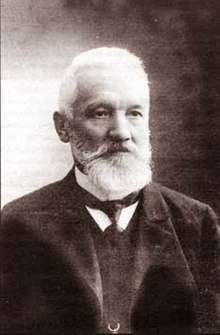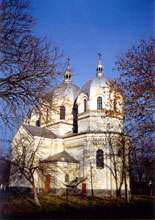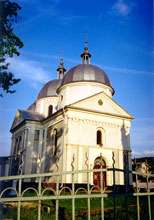Vasyl Nahirny
Vasyl Nahirny (Ukrainian: Василь Нагірний Nahirnyj, Vasyl’) (Hirne, January 11, 1847 – Lviv, February 25, 1921) was an important Ukrainian architect, social activist and public figure; one of the founders of the Ukrainian cooperative movement.
Vasyl Nahirny | |
|---|---|
 | |
| Born | 11 January 1847 Hirne (Stryi Raion) |
| Died | |
| Nationality | Ukrainian |
Biography
Vasyl Nahirny was born on 11 January in Hirne (Stryi Raion).
He graduated Zürich Institute of Technology in 1875. Then he stayed on in Zürich as a lecturer. During that period he became involved with Western European co-operative movements as well as Russian and Ukrainian émigré circles.[1]
In 1882 Nahirny moved in Lviv. In 1883 he wrote a program for the socioeconomic revival of Galicia's Ukrainians at the Second Public Assembly. In the same year the first large Ukrainian consumer co-operative Narodna Torhovlia (People's Trade) was established on the initiative of Vasyl Nahirny and Appolon Nychai. It was headquartered in Lviv and served as a wholesaler to private and community-owned stores in villages and small towns throughout Galicia. Moreover, the co-operative served as a training network for their workers, and as a retailer in the larger cities.[2] Through this cooperative Nahirny hoped to familiarize Ukrainians with commerce and generally support the development of the Ukrainian society of Galicia.[3]
In 1885-1890 Nahirny was an editor of the Lviv newspaper Batkivshchyna published in 1879–1896.[4]
In 1892 he became a co-founder of Dnister Insurance Company alongside with Kost Levytsky, Stepan Fedak, Demian Savchak, and T. Berezhnytsky. It became the oldest and largest Ukrainian insurance company in Galicia (Lviv).[5]

In 1898 the first Ukrainian organization in Galicia concerned with the development of Ruthenian art – Society for the Advancement of Ruthenian Art (Ukrainian: Товариство для розвою руської штуки; Tovarystvo dlia rozvoiu ruskoi shtuky) – was founded. Vasyl Nahirny headed its board of directors.[6]

Vasyl Nahirny also made a significant contribution to the development of a mass physical-education movement Sokol (initiated in Prague in 1862) that propagated national unity, self-confidence, and dignity through physical education. Ukrainian Sokil society was founded in Lviv in 1894 and Vasyl Nahirny became its first president (1894–1900).[7]
Art

Living in Galicia Vasyl Nahirny drew up plans for around 200 Ukrainian Greek Catholic churches. From 1906 he worked with his son Yevhen Nahirny. Though they also successfully worked on designing such secular buildings as private villas, public libraries and others, they became famous for their church designs which incorporated distinctly Ukrainian elements featuring domes, rotunda, bell towers, internal galleries and balconies and iconostasis.[8] He tried to build on the building style of Kyiv, showing the unity of Galicia with the Constantinople Byzantine center and his work laid the foundations of the creation of the modern Galician school of sacred architecture at the turn of the nineteenth and twentieth centuries.[9]
See also
External links
References
- "Nahirny, Vasyl". www.encyclopediaofukraine.com. Retrieved 2020-02-18.
- "Narodna Torhovlia". www.encyclopediaofukraine.com. Retrieved 2020-02-18.
- Orest Subtelny. (1988). Ukraine: a History. Toronto: University of Toronto Press, pp. 324-325 and pp.437-438.
- Himka, John-Paul (1988). Galician Villagers and the Ukrainian National Movement in the Nineteenth Century (PDF). Edmonton, Alberta, Canada: Canadian Institute of Ukrainian Studies. pp. 73–80. ISBN 0-920862-54-3.
- "Dnister Insurance Company". www.encyclopediaofukraine.com. Retrieved 2020-02-18.
- "Society for the Advancement of Ruthenian Art". www.encyclopediaofukraine.com. Retrieved 2020-02-18.
- "Sokil". www.encyclopediaofukraine.com. Retrieved 2020-02-18.
- "A woman's mission to preserve Ukrainian churches | KyivPost - Ukraine's Global Voice". KyivPost. 2019-04-08. Retrieved 2020-02-18.
- "Album of Most Famous Architect of Churches in Galicia Presented in Lviv". risu.org.ua. Retrieved 2020-02-18.